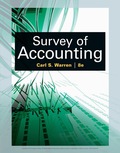
Concept explainers
Concept Introduction:
The fixed assets are of two types, one is tangible and other is intangible. The tangible assets are those which can be touched i.e. having a physical presence. An asset which is used in the business for more than one year and is subject to
Depreciation is the expense which is debited to income statement against the cost of asset i.e. cost of using the asset in the business or in other words, reduction in value due to wear, tear and obsolescence of the asset over its life.
The double-declining-balancing method is the method of computing the depreciation at the rate
The effects of using double-declining-balance depreciation instead of the straight-line method.
Trending nowThis is a popular solution!

Chapter 7 Solutions
Survey of Accounting (Accounting I)
- Brun Company produces its product through two processing departments: Mixing and Baking. Information for the Mixing department follows. Direct Materials Conversion Unit Percent Complete Percent Complete Beginning work in process inventory 7.500 Units started this period 104,500 Units completed and transferred out 100.000 Ending work in process inventory 12.000 100% 25% Beginning work in process inventory Direct materials Conversion $6.800 14.500 $21.300 Costs added this period Drect materials 116,400 Conversion Total costs to account for 1.067,000 1.183.400 $1.204.700 Required 1. Prepare the Mixing department's production cost report for November using the weighted average method Check (1) C$1.000 2. Prepare the November 30 journal entry to transfer the cost of completed units from Mixing to Bakingarrow_forwardNonearrow_forwardNot need ai solution please solve this general accounting questionarrow_forward
- What is the amount of current liabilities the firm has?arrow_forwardNeed answer of this question with financial accountingarrow_forwardThompson Aggrotech has a return on equity of 14.85 percent, a debt-equity ratio of 0.65, and a total asset turnover of 1.1. What is the return on assets?arrow_forward
 Survey of Accounting (Accounting I)AccountingISBN:9781305961883Author:Carl WarrenPublisher:Cengage Learning
Survey of Accounting (Accounting I)AccountingISBN:9781305961883Author:Carl WarrenPublisher:Cengage Learning College Accounting, Chapters 1-27AccountingISBN:9781337794756Author:HEINTZ, James A.Publisher:Cengage Learning,Principles of Accounting Volume 1AccountingISBN:9781947172685Author:OpenStaxPublisher:OpenStax College
College Accounting, Chapters 1-27AccountingISBN:9781337794756Author:HEINTZ, James A.Publisher:Cengage Learning,Principles of Accounting Volume 1AccountingISBN:9781947172685Author:OpenStaxPublisher:OpenStax College Cornerstones of Financial AccountingAccountingISBN:9781337690881Author:Jay Rich, Jeff JonesPublisher:Cengage Learning
Cornerstones of Financial AccountingAccountingISBN:9781337690881Author:Jay Rich, Jeff JonesPublisher:Cengage Learning



